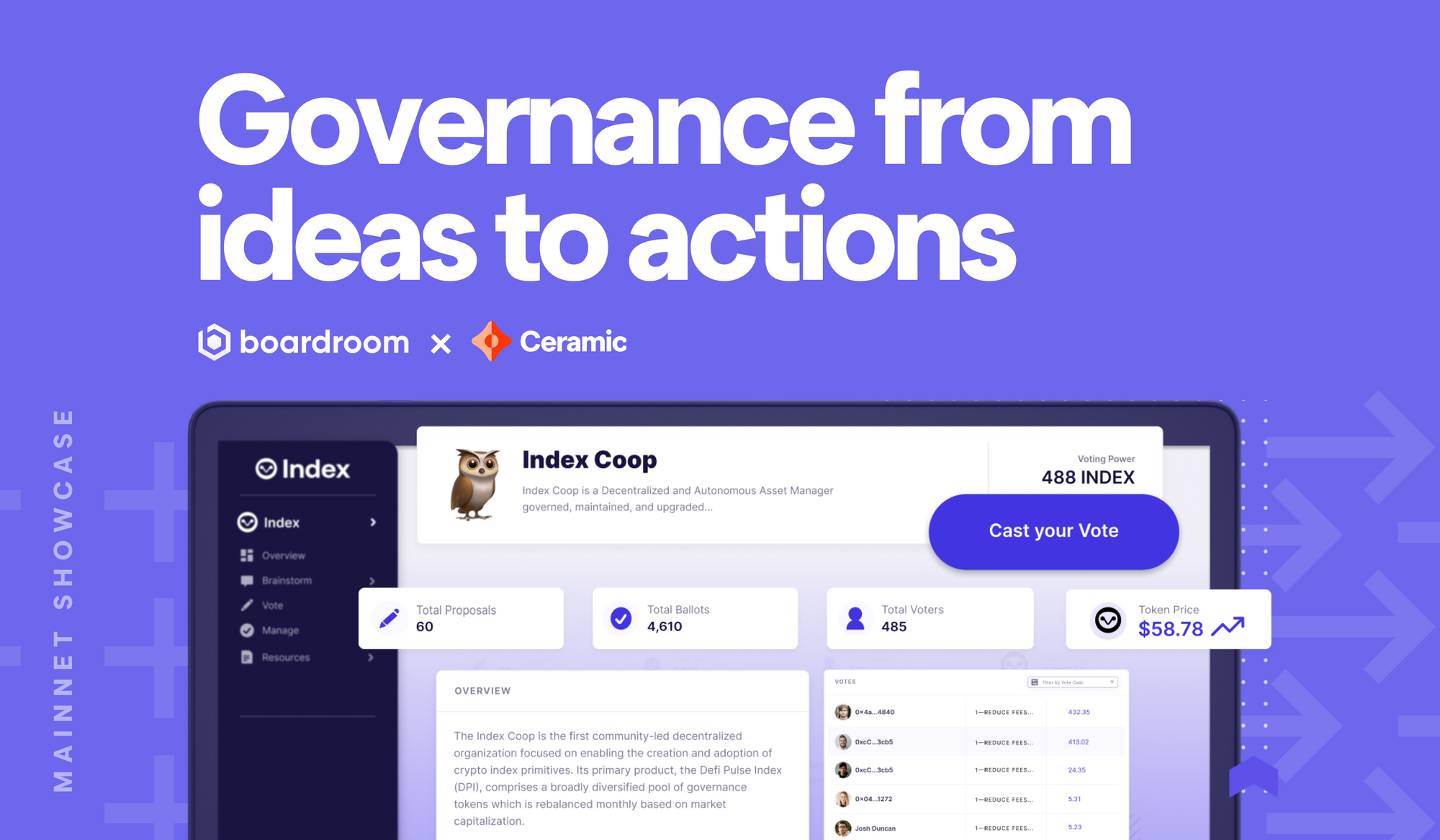Boardroom is bringing context to Web3 governance
The Boardroom governance platform is using Ceramic to bring rich reputations and conversations to DAOs.

Boardroom, the governance middleware platform that powers some of Web3's biggest DAOs, has gone live on Ceramic mainnet. Among the many new features built on Ceramic, Boardroom is debuting an Ideation feature that lets protocol contributors suggest, discuss, and pressure test ideas in a collaborative, censorship-resistant, and fully decentralized way.
Want to try Boardroom’s new Ideation feature? Visit the ShapeShift DAO.
What is Boardroom?
Boardroom is addressing the fragmented governance landscape with a simple and transparent platform for stakeholder management over DAOs and protocols.
As DeFi and DAOs (Decentralized Autonomous Organizations) have exploded in popularity, so has experimentation in new governance methods and tooling. This has led to massive market fragmentation, with no unified experience that serves all aspects of governance together. Today, proposal information, discussion, voting, and execution are splintered across many platforms.
Boardroom intends to fix this. They are building a powerful governance platform that allows many different governance tools to plug into a single seamless framework that can serve an organization throughout all stages of its governance lifecycle.
Governance is more than voting
Voting is often considered a critical part of governance for DAOs, but voting is only the tip of the governance iceberg. Long before any votes are cast, ideas are generated, discussed, signaled, and revised - then they come to a vote and potentially move to on-chain execution. Today, this frequently happens across many platforms and is often done implicitly through back-channels rather than in a clear and explicit way. This process is full of friction and often results in lackluster participation and suboptimal decision-making.
Good governance requires context around all the moving parts, and that was Boardroom's founding motivation: to bring context to governance by unifying the disparate pieces and making sure the relevant information can be surfaced in an easy and clear way to participants.

The Boardroom SDK normalizes data and governance-related actions from across multiple governance frameworks and lets projects build their own, into a single standardized platform. Built on the Boardroom SDK, Boardroom's governance portal provides a consistent, low-friction interface for community members to interact and engage with distributed governance.
As they were building Boardroom, the team recognized that two critical aspects were missing from most governance tools:
- The social layer: Contextualized discussion and debate
- The people layer: Rich, pseudonymous reputations
The social layer: Contextualized discussion and debate
While much emphasis is put on formal proposals and votes, the Boardroom team found that ideation and discussion, while softer, are more influential in governing the direction of projects. Kevin Nielsen, Boardroom co-founder:
The vote is extremely important to actually anchor a specific decision, but the most important part of the actual process is coordinating the human and social layer.
To elevate this part of the governance process and connect it to decision-making, Boardroom is building a set of ideation and forum tools.

On the Boardroom app, each governance proposal will include its own forum for discussion on the same page, presented in a unified experience - with participation restricted to token holders in the network.
Additionally, a new tool designed for ideation allows the community to suggest, show support for, and discuss new ideas before moving to a formal vote. Ideation is a way to get more people involved in the process in a clear, contextualized, and collaborative way. After debuting the Ideation feature last week with the Shapeshift DAO, their community has already generated and discussed several new ideas using Ideation. Here's a preview:
Ceramic Streams: Web3-native content for DAOs
In governance, forum posts and discussions must be trustless and censorship-resistant, or else protocol governance could be shaped by a single party with the power to warp this crucial part of the process - including Boardroom. Storing discussion threads on a server would leave this data susceptible to corruption and posts couldn't just be stored on vanilla IPFS without a management layer to link posts, reactions, and responses together into a consistent thread.
Ceramic provided a perfect solution for this user-generated content, with signed streams of content persisted on a decentralized network. Because Ceramic content is authenticated with the same decentralized identifiers (DIDs) that sit at the heart of IDX and Boardroom's user profiles, users can begin posting to forums without the need to authenticate in a new way. Each piece of content is signed, stored, and controlled by users, then aggregated into the complete thread by the application.
This approach provides a lightweight way to manage rich user content and enables full portability and composability of data. Other governance applications could easily build on top of the same ideation threads outside of the Boardroom UI by referencing the same Ceramic streams or discovering them through a users' IDX. This paves the way for a consistent ideation and discussion layer that can be used everywhere across the governance ecosystem.
The people layer: Rich, pseudonymous reputations
To be maximally effective, governance delegates and participants must be able to build and leverage a reputation. The anonymity provided by obscure hex addresses might be sufficient for one-off financial transactions, however governance is a long-term game and requires continuity across repeated social interactions. For example others might want to know, "Who are the delegates that are consistently making good suggestions, proving their intent, and putting skin in the game?" Says Nielsen:
What we want to highlight with voter profiles is not about real-world identity. It's about mapping stakeholders in the network to their on-chain activity, their previous decisions, and their role. It's contextualizing how they fit into that specific DAO, or ecosystem, or decision.
The fact that many users maintain multiple on-chain accounts and wallets adds complexity to this goal. While this practice may be good for opsec and privacy, it makes it more difficult to construct a unified governance experience for users across all of their accounts. To solve for this, Boardroom needed a way to allow users to link many accounts (and their interactions) together into a unified identity without compromising a user's desire for privacy.
Ceramic IDX: Aggregated identities for users
This is why Boardroom is moving their identity system and user profiles to IDX - the identity protocol built on top of Ceramic. In addition to storing profiles and other arbitrary information, IDX lets users link multiple on-chain accounts to the same identity, as well as prove ownership of various Web2 accounts such as Twitter, Github, and Discord.
As more projects like Rabbithole, Sourcecred, and Gitcoin begin to also use IDX for identity and user data storage, a user's history of on-chain and off-chain transactions can aggregate into a unified, cross-platform reputation which can be used everywhere across the Web3 ecosystem.
All of this information stored in IDX results in a rich source of user context which doesn't just aid the voting process, but rather adds value to every stage of engagement and governance across the Web3 ecosystem — all while staying pseudonymous.
Connecting the governance ecosystem
With Ceramic and IDX, Boardroom is building a DAO governance platform that brings together the on-chain, social, and human layers in a way that is lightweight and ready to scale. Said YJ Kim, engineer and co-founder of Boardroom:
We initially thought we'd need to use Discourse forums for ideation. But data is not easy to fetch from the Discourse API, we can’t make a PR to suit our needs since it’s closed source software, and each integration required the forum admins to manually whitelist our IP.
IDX allows Boardroom to build a focused, web3 version such that future applications both within Boardroom and in the broader governance ecosystem don’t have to face those hurdles. Everything is just...there. That not only makes future iterations easier, but also if a user begins using some other application built on IDX, we’ll be able to easily plug that data right into our portal if we wanted to - and vice versa.
What's next for Boardroom?
Boardroom recently announced the addition of projects using Governor Alpha, Governor Bravo, and AAVE-based governance frameworks to their platform, adding to existing integrations such as Snapshot. Any projects using these frameworks can easily onboard to Boardroom's platform and use their governance portal interface to vote, delegate, ideate, track treasury distributions, and more.
For projects using modified versions of these frameworks, Boardroom will work with teams to build adapters as needed. Start using Boardroom via their website, follow them on Twitter, or join the discussion in their discord community.
Website | Twitter | Discord | GitHub | Documentation | Blog | IDX Identity

